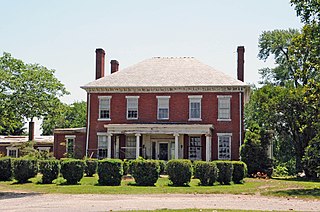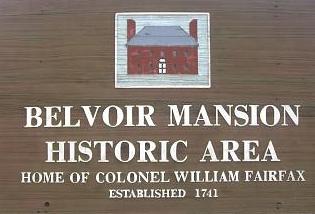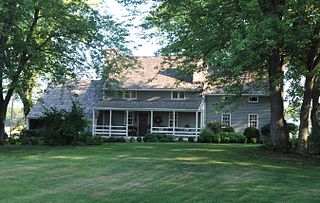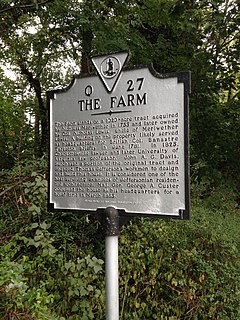
Bruton Parish Church is located in the restored area of Colonial Williamsburg in Williamsburg, Virginia, United States. It was established in 1674 by the consolidation of two previous parishes in the Virginia Colony, and remains an active Episcopal parish. The building, constructed 1711–15, was designated a National Historic Landmark in 1970 as a well-preserved early example of colonial religious architecture.

The Criel Mound, also known as the South Charleston Mound, is a Native American burial mound located in South Charleston, West Virginia. It is one of the few surviving mounds of the Kanawha Valley Mounds that were probably built in the Woodland period after 500 B.C. The mound was built by the Adena culture, probably around 250–150 BC, and lay equidistant between two “sacred circles”, earthwork enclosures each 556 feet (169 m) in diameter. It was originally 33 feet (10 m) high and 173 feet (53 m) in diameter at the base, making it the second-largest such burial mound in the state of West Virginia. This archaeological site is listed on the National Register of Historic Places.

The Grave Creek Mound in the Ohio River Valley in West Virginia is one of the largest conical-type burial mounds in the United States, now standing 62 feet (19 m) high and 240 feet (73 m) in diameter. The builders of the site, members of the Adena culture, moved more than 60,000 tons of dirt to create it about 250–150 BC.

Varina Farms, also known as Varina Plantation or Varina Farms Plantation or Varina on the James, is a plantation established in the 17th century on the James River about 10 miles (16 km) south of Richmond, Virginia. An 820-acre (330 ha) property was listed on the National Register of Historic Places in 1977 as "Varina Plantation". At that time it included two contributing buildings and one other contributing site.

Mount Airy, near Warsaw in Richmond County, Virginia, constructed in 1764 for Colonel John Tayloe II, perhaps the richest Virginia planter of his generation, is a mid-Georgian plantation house, the first built in the manner of a neo-Palladian villa. John Ariss is the attributed architect and builder. Tayloe's daughter, Rebecca and her husband Francis Lightfoot Lee, one of the only pair of brothers to sign the Declaration of Independence are buried on the estate, as are many other Tayloes. Before the American Civil War, Mount Airy was a prominent racing horse stud farm, as well as the headquarters of about 10-12 separate but interdependent forced-labor plantations along the Rappahannock River. Mount Airy is listed on the National Register of Historic Places as a National Historic Landmark as well as on the Virginia Landmarks Register and is still privately owned by Tayloe's descendants.

Berry Hill Plantation, also known simply as Berry Hill, is a historic plantation located on the west side of South Boston in Halifax County, Virginia, United States. The main house, transformed c. 1839 into one of Virginia's finest examples of Greek Revival architecture, was designated a National Historic Landmark in 1969. The surviving portion of the plantation, which was once one of the largest in the state, is now a conference and event center.

Claymont Court, or simply Claymont, is a Georgian-style brick mansion, the grandest of several built near Charles Town, West Virginia for members of the Washington family. The current "Big House" was built in 1840 for Bushrod Corbin Washington, nephew of Supreme Court justice Bushrod Washington and grand-nephew of George Washington, to replace the 1820 main house on his plantation that burned in 1838.

The Gibson-Todd House was the site of the hanging of John Brown, the abolitionist who led a raid on Harpers Ferry, West Virginia before the opening of the American Civil War. The property is located in Charles Town, West Virginia, and includes a large Victorian style house built in 1891.

Beall-Air, also known as the Colonel Lewis William Washington House, is a two-story stuccoed brick house in classical revival style near Halltown, West Virginia. It was the home of Colonel Lewis William Washington, great-great nephew of President George Washington and hostage in John Brown's raid on Harpers Ferry, West Virginia.

The Allstadt House and Ordinary was built about 1790 on land owned by the Lee family near Harpers Ferry, West Virginia, including Phillip Ludwell Lee, Richard Bland Lee and Henry Lee III. The house at the crossroads was sold to the Jacob Allstadt family of Berks County, Pennsylvania in 1811. Allstadt operated an ordinary in the house, and a tollgate on the Harpers Ferry-Charles Town Turnpike, while he resided farther down the road in a stone house. The house was enlarged by the Allstadts c. 1830. The house remained in the family until the death of John Thomas Allstadt in 1923, the last survivor of John Brown's Raid.

Belvoir was the plantation and estate of colonial Virginia's prominent William Fairfax family. Operated with the forced labor of enslaved people, it sat on the west bank of the Potomac River in Fairfax County, Virginia, at the present site of Fort Belvoir. The main house — called Belvoir Manor or Belvoir Mansion — burned in 1783 and was destroyed during the War of 1812. The site has been listed on the National Register of Historic Places since 1973 as "Belvoir Mansion Ruins and the Fairfax Grave."

The Thomas Brown House in Inwood, West Virginia, was built about 1741 as a log cabin for Thomas Brown, a Quaker farmer. Brown was one of the first to grow fruit in an area where orchardry would become a major agricultural industry. The house is the oldest known dwelling in Berkeley County.

The Col. James Graham House is a historic log cabin located on West Virginia Route 3 in Lowell, West Virginia. It was built in 1770 as a home for Col. James Graham, the first settler of Lowell, and his family. It was later the site of an Indian attack on the Graham family in 1777. The house was added to the National Register of Historic Places on March 16, 1976. The Graham House is the oldest multi-story log cabin in West Virginia. It is currently operating as a museum.

James W. Hoge House is a historic home located in Winfield, Putnam County, West Virginia. Its owner, James W. Hoge, was a lawyer and judge, who represented Putnam County at the Virginia Secession Convention of 1861, voting against the ordinance in April but signing the ordinance later in June. He lived in the house from 1857 until his death in 1882. Charles Brown, who operated a ferry across the Kanawha River using enslaved labor built this house in 1838, and his son Tallyrand inherited it circa 1848 and rented it out until ultimately selling it in 1852, to Capt. John Bowyer (1794-1878), a veteran of the War of 1812 who became Justice of the Peace for Putnam County in 1848, and also served in the West Virginia House of Delegates. In 2004 it was moved a short distance to its current location in what had been the Hoge family graveyard, to save it from demolition. The single-story, Federal-style side-gable brick dwelling measures 18 feet by 47 feet, and features stepped parapets at the gable ends and a decorative brick cornice. Also on the property is the Hoge Cemetery, containing approximately 24 graves of Hoge family members, as well as unmarked graves of slaves.
Morlunda, also known as the Col. Samuel McClung Place and Oscar Nelson Farm, is a historic home located near Lewisburg, Greenbrier County, West Virginia. It was built in 1827–1828, and consists of a main house with ell. The main house is a two-story brick building measuring 56 feet long and 21 feet deep. The ell measures 48 feet and it connects to a 1+1⁄2-story formerly detached kitchen.
Elmer F. Jacobs was a Morgantown, West Virginia-based architect.

Robert C. Woods House, also known as the Jacob S. Rhodes House, is a historic home located at Wheeling in Ohio County, West Virginia, United States. It was built between 1839 and 1845, and is a 2+1⁄2-story, 13-room brick dwelling, with an Italianate-style facade. It measures 32 feet by 90 feet, with a front block 45 feet deep and rear wing of 45 feet. The front facade features curved cast-iron lintels.

Hopewell Friends Meeting House is an 18th-century Quaker meeting house located the northern Frederick County, Virginia one mile west of the community of Clear Brook at 604 Hopewell Road. Clear Brook, VA 22624. This community was the home of Thomas William "Tom" Fox (1951–2006), a Quaker peace activist, affiliated with Christian Peacemaker Teams (CPT) murdered in 2006 in Iraq.

The historic home listed as Lewis Farm, also known as The Farm and John A. G. Davis Farm, is located at Charlottesville, Virginia. It was built in 1826, and is a two-story brick dwelling with a low hipped roof and two large chimneys. On the front facade is a Tuscan order portico with a terrace above. The house was built by individuals who worked with Thomas Jefferson on building the University of Virginia. Its builder, John A. G. Davis, was law professor at the University of Virginia and was shot and killed outside Pavilion X by a student in 1840. During the American Civil War, Brigadier General George Armstrong Custer set up temporary headquarters at the house where he remained for three days.

The Morgan Morgan Monument, also known as Morgan Park, is a 1.05-acre (0.4 ha) roadside park in the unincorporated town of Bunker Hill in Berkeley County, West Virginia. It is located along Winchester Avenue and Mill Creek. The park features a granite monument that was erected in 1924 to memorialize Morgan Morgan (1688–1766), an American pioneer of Welsh descent, who was among the earliest European persons to settle permanently within the present-day boundaries of West Virginia.




















